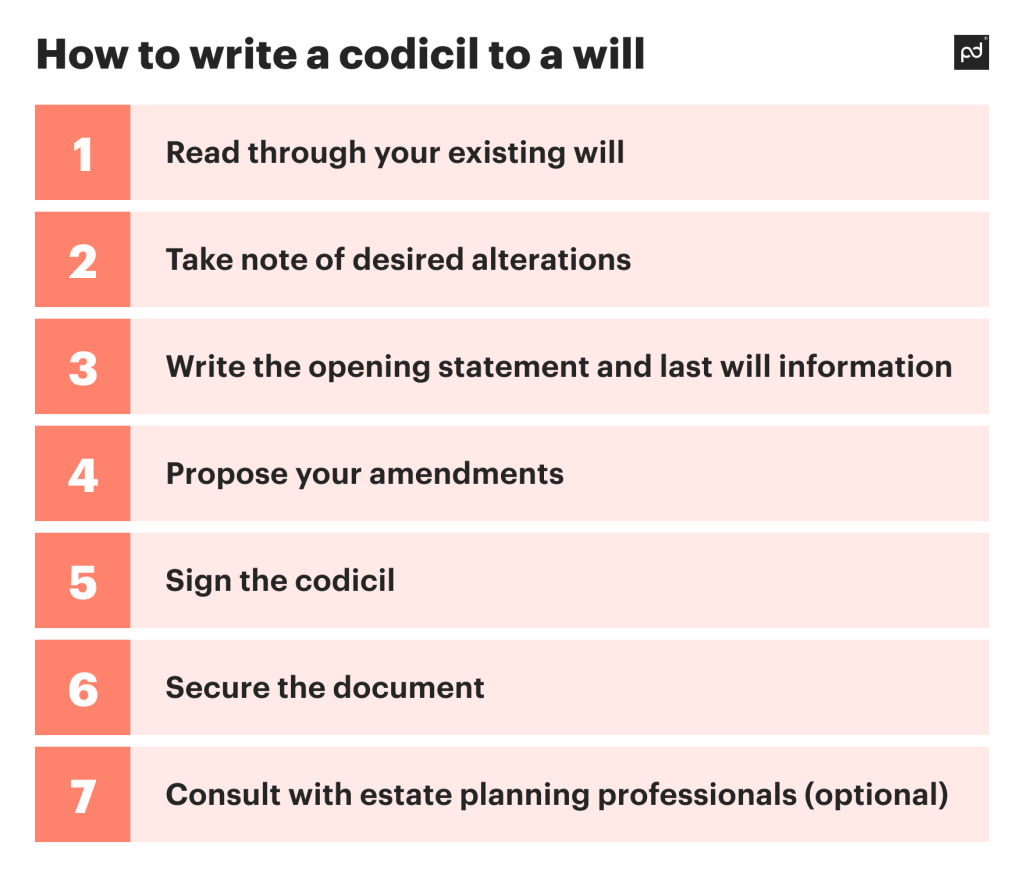Writing a will isn’t usually the easiest or most uplifting of tasks, and unless you’re drafting it on your deathbed, circumstances can and do change.
That’s where a codicil to a will comes in, allowing you to update your estate planning documents and make sure they accurately reflect your intentions.
Key takeaways:
- In many circumstances, a codicil is a useful option for amending a last will and testament.
- Writing a codicil is a relatively simple process and doesn’t typically require a lawyer.
- You should read through your will and make a note of the desired changes before adding a codicil.
- You can use both online and offline resources to help you adhere to the legal requirements in your jurisdiction.
- A codicil can be a quick and efficient way to take care of matters like replacing an executor or adding a beneficiary.
What is a codicil to a will?
Adding a codicil is a legal way to modify or alter your last will and testament.
The codicil functions as an addendum to your existing will, enabling you to add or remove sections to more accurately reflect your intentions and current estate.
Codicils can be a great way to avoid rewriting an entire legal document.
They can also prevent confusion if certain circumstances change post-writing your will.
A codicil is often a painless way to make minor corrections or amendments to a will.
Codicils made a lot of sense in prior centuries when all legal documents were handwritten or drafted on typewriters, providing a simple way to amend the terms of a will without having to re-draft the entire legal document.
Today, altering electronic documents makes changing or redrafting a will much more straightforward.
However, a codicil can still be helpful to alter bequeathments — for example, after the birth of a child or the death of a beneficiary.
So, codicils still have their place, but you have to be careful when creating them. Write too many, and you might invalidate a will without meaning to.
Can I add a codicil to my will myself?
You can legally add a codicil to your will without enlisting the help of a lawyer. In fact, you, as the testator, are the only person who can create and add a codicil.
Even if you’ve given power of attorney (POA) to a professional, they can’t create one without your signature of approval. In other words, a codicil can’t be added after your death.
It can be as simple as writing your updated wishes by hand (as long as certain standards are met).
When done correctly, the relevant section of the document will be amended or even entirely deleted as instructed.
Of course, like most things, it’s better to be safe than sorry.
When deciding whether to add a codicil, it’s best practice to consult online legal sources and/or speak with estate planning lawyers.
If you’re unsure of how to add a codicil or even write a will initially, you can get started with a free last will and testament template.
How to write a codicil to a will
Adding a codicil to a will doesn’t have to be complicated.
The entire purpose of codicils is to streamline amendments to your estate planning documents.
You can start crafting a codicil to a will by following these simple steps.

1. Read through your existing will
It might have been years or even decades since you and your legal representatives put together your original will, so before you make any changes, give it a thorough read-through and refamiliarize yourself with its content.
2. Take note of desired alterations
Next, make note of any sections that need to be amended or updated.
This will ensure you don’t miss anything (or end up needing to write another codicil).
3. Write the opening statement and last will information
Use the first line to indicate that you’re writing a codicil to your will.
Also, include information that identifies this as your particular last will and testament.
Identifying info, such as your full name and residence, and the date should be included.
Provide information about your original will and the date it was signed too.
4. Propose your amendments
Next, list each of your proposed changes as though they’re an addendum to a contract.
Firstly, indicate which clauses are being modified, and then specify your desired alterations.
Be sure to use clear and concise language when amending a will; keeping it simple avoids having your will held up in probate court if someone decides to contest the codicil.
5. Sign the codicil
Think about what makes a will legal in your jurisdiction. A codicil will need to adhere to similar criteria to be upheld in probate court.
For example, you’ll need to attest that you’re of sound mind and have witnesses who can sign the document.
Once you’re happy with the proposed changes to your will, it’s time to signify your approval by signing the document.
As we mentioned a moment ago, most states require the signatures of two witnesses as well.
Neither these witnesses nor their spouses should be beneficiaries or executors of the will. Some states may have other requirements too.
For example, Louisiana requires the signatures of all parties to be notarized.
Some jurisdictions do allow e-signatures on wills and codicils in 2023. If you live in one of them, you can use our free PandaDoc electronic signature tool to sign.
Adding signatures in this way is a breeze and will ensure your legal document is ready in no time.
6. Secure the document
It may sound like a no-brainer, but all of your legal documents, especially those concerning your estate, should be kept somewhere safe.
In this case, we’d advise storing your codicil with your other estate planning documents.
7. Consult with estate planning professionals (optional)
Either before or after drafting the proposed changes to your will, it’s a good idea to consult with an attorney or law firm.
They can ensure that local state requirements are met, so your codicil will definitely hold up in a court of law.
Sample codicil to a will
The following is an example of how to structure a codicil to a will:
Codicil to the Last Will and Testament of [Your Name]
I, [Your Name], the ‘Testator’ of [City/State of Residence], [Date], declare this to be a codicil to my last will and testament dated [Original Will Date]:
Amendment 1: [Describe the specific amendment or addition you want to make to your will, such as changing a beneficiary, modifying a bequest, or appointing a new executor]. This amendment shall supersede and replace the corresponding provision in my original will.
Amendment 2: [Describe the second amendment or addition, if applicable]
Amendment 3: [So on as needed]
I affirm that all other provisions of my original will remain in full force and effect, except as expressly modified by this codicil.
In all other respects, I hereby confirm and republish my Last Will as dated [Codicil Date] and any prior codicils.
I declare that this codicil has been executed voluntarily and without any undue influence or duress.
In witness whereof, I sign my name on [Today’s Date] in the presence of the undersigned witnesses, who witnessed and subscribed this codicil at my request and in my presence.
Witness 1: Name: Address: Signature: Date:
Witness 2: Name: Address: Signature: Date:
Testator: Name: Address: Signature: Date:
This is a general example to give you an idea of what a codicil might look like rather than a legal document.
As always, it’s best to consult with an estate planning attorney and/or other legal resources before drafting a codicil.
These will help you meet and understand any applicable legal requirements with regard to your specific jurisdiction and circumstances.
When and why you may want to add a codicil to your will
Adding a codicil to a will is not a one-size-fits-all solution. Sometimes, it may be better to just update and revise your current will.
That being said, there are still plenty of situations where a codicil is appropriate.

Change of executor
There are many reasons why you may want to change the executor of your will, including death, divorce, or a difference of opinion.
This is important because your executor should be someone you trust to uphold your wishes and amiably handle disputes when you’re not there to speak for yourself.
Essentially, a codicil can be useful as a quick fix when life throws a curveball involving your current executor, allowing you to easily nominate someone else in their stead.
Changes in bequeathments
Death, divorce, or the birth of a child can all change how and to whom you want to bequeath your estate.
For example, if you were planning on leaving certain elements of your estate to one of your relatives but they passed unexpectedly before you, this part of your will would likely be challenged in probate court after your death.
With a codicil, however, you could amend these bequeathments so they went to your deceased relative’s children or spouse instead, eliminating any confusion or legal debates.
Moving to another state
Every legal document in the United States is subject to local jurisdiction.
If you and your estate planning lawyer created your will in another state, it may not adhere to or contain clauses essential under a different state’s laws.
A codicil allows you to amend your last will and testament to ensure it’s legally binding in your new state of residence.
With a carefully researched codicil, you can sleep soundly, knowing your wishes will be executed as you want them to be.
The birth or adoption of a child
Life can throw you a lot of surprises.
Maybe you’re a thoughtful, prepared individual who’s had your will written since you were relatively young. What happens if you then have a child (or grandchild) who isn’t included in it?
With your existing will, a newly adopted or born child may have limited claim to any part of your estate, even if you wish them to, and due to the language in it, your executor’s hands may be tied in terms of giving them anything at all.
Fortunately, a codicil is one way to easily ensure that the newest addition to your family inherits in line with your wishes.
New laws are passed
After a will is written, it can occasionally be affected by newly passed legislation.
The most common example of this is changes in state tax laws.
Another example might be new estate law requirements. In either case, document clauses like bequeathments and beneficiaries may need to be updated.
You can make the required amendments using a codicil to save time and money and stay up to date with any legal requirements.
Significant financial or asset changes
Sometimes, you can hit it big and pull in unaccounted-for wealth.
On the other hand, perhaps you make a major purchase like buying a property.
These new assets can be a headache for probate courts as many beneficiaries could try to stake a claim to them.
A clearly defined addendum to your will can clarify what you want to happen to any parts of your estate that aren’t covered in your will and how you would like these to be managed.
Does a codicil have to be notarized?
In many states, your codicil won’t have to be notarized — but notarization does provide solid evidence of a document’s authenticity.
In these cases, it’s best to do your research and/or consult with a legal professional to determine the usefulness of notarizing it.
If you do decide to go down the route of notarizing your document, it’s often possible to do this online, and remote online notarization with PandaDoc can significantly streamline the document authentication process.
What the majority of jurisdictions do require is for two witnesses to be present at the time of the testator signing the codicil.
Additionally, estate planning lawyers may ask you to sign a self-proving affidavit depending on the state.
This legal document allows your codicil to your will to be executed without the need for one or all of your witnesses to show up in court and testify to this.
A codicil: The answer to how to amend a will without a lawyer
You’ll probably spend considerable time and money on creating your last will and testament.
Once this process is complete, you’ll hope to pack it away and forget about it — after all, you don’t plan on being around the next time it makes an appearance!
But life doesn’t always go according to plan (hence the creation of your will in the first place).
Should relationships change, finances improve, or a child be born, it can throw a real wrench into your estate planning.
Instead of paying significant consultation fees to a lawyer, you have another option to amend a will: follow the steps listed in this article, use plain language, and execute your changes using a codicil to a will instead.
Disclaimer
PandaDoc is not a law firm, or a substitute for an attorney or law firm. This page is not intended to and does not provide legal advice. Should you have legal questions on the validity of e-signatures or digital signatures and the enforceability thereof, please consult with an attorney or law firm. Use of PandaDocs services are governed by our Terms of Use and Privacy Policy.


